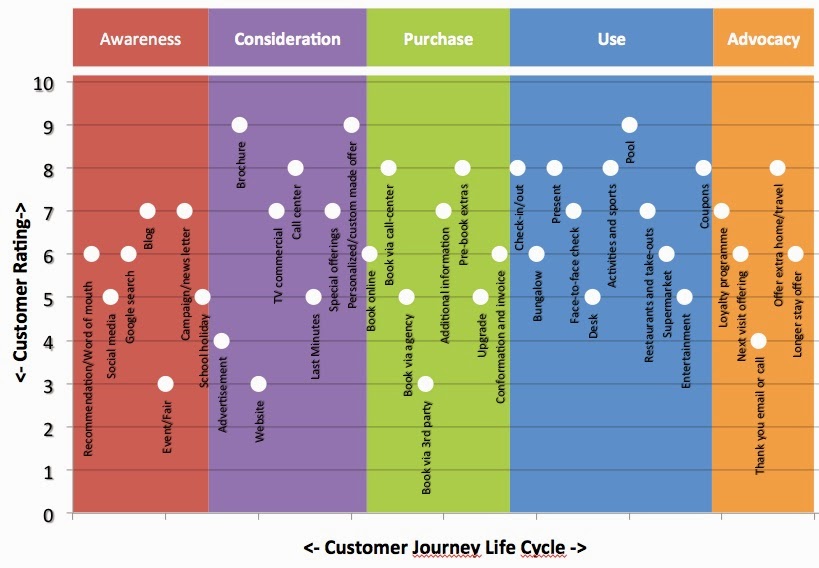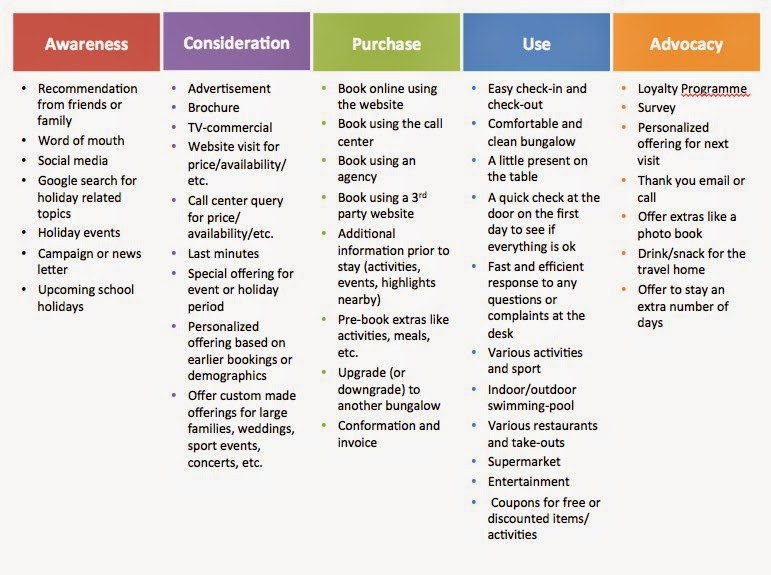In two earlier blogs we have discussed one of the trending topics in the CRM field, Customer Experience Management (CEM). As stated, CEM intentionally tries to direct the experiences of a customer or prospect across all touch points with your company.
As a first attempt to present some hands-on tools to execute CEM within your company, we have discussed the customer touchpoint analysis and the Net Promotor Score (NPS) in the previous CEM blog. A relevant subsequent step is to visualize all the touchpoints and their scores in a customer journey. It is the virtual journey that our customer will make through our company using all related touchpoints when buying our product or service offering. Again the customer journey could be defined on company level, providing a complete overview of all touchpoints per phase, or on a lower and so more detailed level, providing a journey per customer facing process or persona.
The following example shows the customer journey on company level for a fictional holiday bungalow park. Here we have visualized all relevant touchpoints through the customer life cycle phases:
On a more detailed level one can create the customer journey for a prospect visiting the website and booking a stay or a customer journey for a loyal customer filing a complaint at the reception desk.
Combining the customer journey with a score or rating per individual step in this journey would give a good insight on possible optimizations. The challenge is knowing how to collect these scores. Naturally, one should get these scores from the customer. The Net Promotor Score has been discussed before, where the customer is challenged at the end of each interaction to provide us with a rating. Customer research, customer panels or focus groups are other possibilities to get a better understanding on how our customers score us during the customer journey. Obviously, getting these scores from the customer will cost time and money. It should be possible to start relatively cheap and pragmatic by visualizing the customer journey and estimating these rates internally based on learnings from the past and input from employees who are in direct contact with the customer. Often it is a surprise what insights can come from our account managers and our call center on a customer experience level. CEM should be an organic implementation in which we will be able to challenge our initial hypotheses with true customer ratings at a later stage.

A common mistake is that every step in a customer journey should get a high score. By nature, a journey will have its ‘pains’ and ‘pleasures’. Within a product buying journey the actual payment step will always be the pain moment in the process, although payment ease, choice in payment methods and security will improve the score. Studies show that companies should target for a customer journey with a peak experience and a good journey end. The peak (often referred to as the ‘wow’ experience) is a memorable, branded experience that exceeds customer expectations. It could be as simple as a free sample or an extra in the delivery, the personal note of an employee, the guidance to a cheaper or better solution, etc. A good end is just about meeting the customer expectation, the timely delivery, the clear order fulfillment process, etc.
To conclude this CEM blog, it is nice to notice that SAP itself is also working on the enhancement of the traditional CRM solutions with CEM elements. Topics around customer experience and customer engagement will play a significant role in the near future. The most explicit statement for that is the renaming of the CRM product portfolio to SAP Customer Engagement & Commerce (SAP CEC).
In the next CEM related blog it would like to discuss some examples of how the SAP CEC solutions can assist you in practicing CEM.






